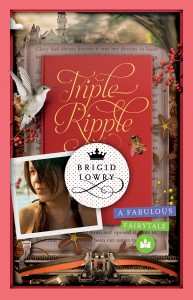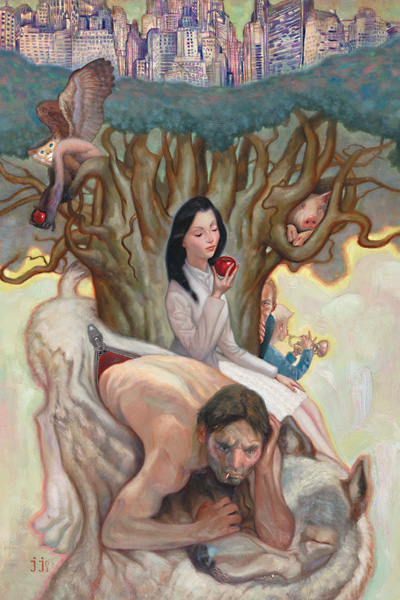Today’s fairy tale features: The tiniest kingdom in the world, a haughty mouse who has evil designs on the royal children, marionettes, and a wicked ostrich. It’s a French tale, so that also means there are lots of knowing in-jokes about the Ways of Royalty, the Foibles of Vanity, and also Abuse of Power.
Once upon a time there lived a king and queen who ruled over a country so small that you could easily walk round it in one day. They were both very good, simple people; not very wise, perhaps, but anxious to be kind to everybody; and this was often a mistake, for the king allowed all his subjects to talk at once, and offer advice upon the government of the kingdom as well as upon private matters. And the end of it all was, that it was very difficult to get any laws made, and, still more, to get anyone to obey them.
Now, no traveller ever passed through the kingdom without inquiring how it came to be so small. And this was the reason. As soon as Petaldo (for that was the king’s name) had been born, his father and mother betrothed him to the niece of their friend the fairy Gangana — if she should ever have one. But as the years passed on, and Gangana was still without a niece, the young prince forgot all about his destined bride, and when he was twenty-five he secretly married the beautiful daughter of a rich farmer, with whom he had fallen violently in love.
When the fairy heard the news she fell into a violent rage, and hurried off to tell the king. The old man thought in his heart that his son had waited quite long enough; but he did not dare to say so, lest some dreadful spell might be thrown over them all, and they should be changed into birds or snakes, or, worst of all, into stones. So, much against his will, he was obliged to disinherit the young man, and to forbid him to come to court. Indeed, he would have been a beggar had it not been for the property his wife had had given her by the farmer, which the youth obtained permission to erect into a kingdom.
Most princes would have been very angry at this treatment, especially as the old king soon died, and the queen was delighted to reign in his place. But Petaldo was a contented young man, and was quite satisfied with arranging his tiny court on the model of his father’s, and having a lord chamberlain, and a high steward and several gentlemen in attendance; while the young queen appointed her own ladies-in-waiting and maids of honour. He likewise set up a mint to coin money, and chose a seneschal as head of the five policemen who kept order in the capital and punished the boys who were caught in the act of throwing stones at the palace windows.
The first to fill this important office was the young king’s father-in-law, an excellent man of the name of Caboche. He was much beloved by everyone, and so sensible that he was not at all vain at rising at once to the dignity of seneschal, when he had only been a common farmer, but went about his fields every day as usual. This conduct so struck his king that very soon he never did anything without consulting him.
Each morning Caboche and his son-in-law had breakfast together, and when they had finished, the king took out of his iron chest great bundles of state papers, which he desired to talk over with his seneschal. Sometimes they would spend two hours at least in deciding these important matters, but more often after a few minutes Caboche would say:
‘Excuse me, sire, but your majesty does not understand this affair in the least. Leave it to me, and I will settle it.’
‘But what am I to do, then ?’ asked the king. And his minister answered:
‘Oh, you can rule your wife, and see after your fruit garden. You will find that those two things will take up all your time.’
‘Well, perhaps you are right,’ the king replied; secretly glad to be rid of the cares of government. But though Caboche did all the work, Petaldo never failed to appear on grand occasions, in his royal mantle of red linen, holding a sceptre of gilded wood. Meanwhile he passed his mornings in studying books, from which he learned the proper seasons to plant his fruit trees, and when they should be pruned; and his afternoons in his garden, where he put his knowledge into practice. In the evening he played cards with his father-in-law, and supped in public with the queen, and by ten o’clock everybody in the palace was fast asleep.
The queen, on her side, was quite as happy as her husband. She loved to be in her dairy, and nobody in the kingdom could make such delicious cheeses. But however busy she might be, she never forgot to bake a little barley cake, and make a tiny cream cheese, and to put them under a particular rose-tree in the garden. If you had asked her whom they were for, and where they went to, she could not have told you, but would have said that on the night of her marriage a fairy had appeared to her in a dream, and had bidden her to perform this ceremony.
After the king and the queen had six children, a little boy was born, with a small red cap on his head, so that he was quite different from his brothers and sisters, and his parents loved Cadichon better than any of them.
The years went on, and the children were growing big, when, one day, after Gillette the queen had finished baking her cake, and had turned it out on a plate, a lovely blue mouse crept up the leg of the table and ran to the plate. Instead of chasing it away, as most women would have done, the queen pretended not to notice what the mouse was doing, and was much surprised to see the little creature pick up the cake and carry it off to the chimney. She sprang forwards to stop it, when, suddenly, both the mouse and cake vanished, and in their place stood an old woman only a foot high, whose clothes hung in rags about her. Taking up a sharp pointed iron stick, she drew on the earthen floor some strange signs, uttering seven cries as she did so, and murmuring something in a low voice, among which the queen was sure she caught the words, ‘faith,’ ‘wisdom,’ ‘happiness.’ Then, seizing the kitchen broom, she whirled it three times round her head, and vanished. Immediately there arose a great noise in the next room, and on opening the door, the queen beheld three large cockchafers, each one with a princess between its feet, while the princes were seated on the backs of three swallows. In the middle was a car formed of a single pink shell, and drawn by two robin red-breasts, and in this car Cadichon was sitting by the side of the blue mouse, who was dressed in a splendid mantle of black velvet fastened under her chin. Before the queen had recovered from her surprise, cockchafers, red-breasts, mouse and children had all flown, singing, to the window, and disappeared from view.







